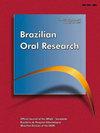XP Endo Finisher-R and PUI as supplementary methods to remove root filling materials from curved canals.
IF 2.5
4区 医学
Q2 Dentistry
引用次数: 3
Abstract
This study assessed the ability of XP-endo Finisher R (FKG, La Chaux-de-Fonds, Switzerland) to remove filling remnants from curved mesiobuccal canals of maxillary molars, using the passive ultrasonic irrigation (PUI) technique as a comparison. Twenty-four curved main mesiobuccal canals (MB1) of maxillary molars were instrumented with Wave One (#25/07) and filled with gutta-percha points and AH Plus Sealer. Samples were then re-treated with a standardized protocol with Wave One (#35/06) as the master apical file. Micro-CT scans measured baseline volume of remaining filling material (in mm3). Samples were divided into two groups (n = 12) according to the supplementary cleaning approach: (PUI) or XP-endo Finisher R. Statistics compared baseline and final volume of filling material (within-group); and the percentage of filling material reduction (between-group). Mean baseline volumes, final volumes, and percentages of reduction (%) of filling material for XP-endo Finisher R and PUI were respectively: 0.060 mm3, 0.042 mm3, and 31.28%; and 0.064 mm3, 0.054 mm3, and 16.57%. Both tested protocols reduced the amount of filling material (p < 0.05). XP-endo Finisher R had higher percentage of reduction as compared to PUI (p < 0.05). XP-endo Finisher R and PUI used as supplementary cleaning protocols during re-treatment improved the removal of root filling material in curved canals; but XP-endo Finisher R was approximately twice more efficient. The complete filling material removal during re-treatment procedures is still a challenge. Supplementary cleaning protocols may help to remove the remaining material after the complete mechanical preparation of curved canals. XP-endo Finisher R was approximately twice more efficient than PUI.XP Endo finier - r和PUI作为去除弯曲管根充填材料的补充方法。
本研究评估了XP-endo Finisher R (FKG, La Chaux-de-Fonds, Switzerland)去除上颌磨牙弯曲中颊管填充物残留物的能力,采用被动超声灌洗(PUI)技术作为比较。采用Wave 1(#25/07)对24个上颌磨牙弯曲的中颊主管(MB1)进行矫治,并使用胶点和AH Plus Sealer填充。然后以Wave One(#35/06)作为主要的根尖文件,用标准化的方案重新处理样品。显微ct扫描测量了剩余填充材料的基线体积(单位为mm3)。根据补充清洁方式(PUI)或XP-endo Finisher r将样品分为两组(n = 12):统计学比较基线和最终填充材料体积(组内);和填充材料减少百分比(组间)。XP-endo Finisher R和PUI的平均基线体积、最终体积和填充材料减少百分比(%)分别为:0.060 mm3、0.042 mm3和31.28%;0.064 mm3 0.054 mm3和16.57%。两种测试方案均减少了填充材料的数量(p < 0.05)。与PUI相比,XP-endo R的还原率更高(p < 0.05)。再处理时使用XP-endo Finisher R和PUI作为辅助清洁方案,可改善弯曲管根充填材料的去除;但XP-endo Finisher R的效率大约是其两倍。在再处理过程中完全去除填充材料仍然是一个挑战。辅助清洁方案可能有助于去除弯曲管完全机械准备后残留的物质。XP-endo Finisher R的效率大约是PUI的两倍。
本文章由计算机程序翻译,如有差异,请以英文原文为准。
求助全文
约1分钟内获得全文
求助全文
来源期刊

Brazilian Oral Research
DENTISTRY, ORAL SURGERY & MEDICINE-
CiteScore
3.70
自引率
4.00%
发文量
107
审稿时长
12 weeks
 求助内容:
求助内容: 应助结果提醒方式:
应助结果提醒方式:


